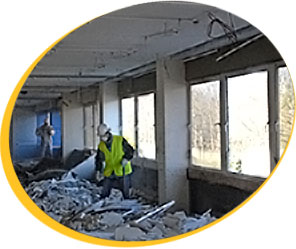
Despite several campaigns put in place to persuade homeowners to be conscious of the risks of asbestos in older homes, the majority of us could still not recognize it perhaps we come across while carrying out some DIY work. Although professionals may be able to tell what it looks like and how handle it, homeowners in the UK are extremely doubtful to even identify it. let alone know what to do. So what are the hazards, how do we work out if we might be exposed to it and how do we remove it carefully?
Asbestos is a mineral that has been used throughout history to construct rigid walls and use in circumstances where fire resistant materials were necessary. It was distributed all over the UK from the 1950’s into the 1980’s, until it was exposed as causing numerous chronic lung conditions which led to a great many early deaths. If significant levels of asbestos dust are breathed in, it can cause difficulties that might not appear for up to 30 years later. A condition called mesothelioma is typically caused due to asbestos exposure.
If your house was constructed in this time period, then asbestos could well be already in your gutters, in your garage or roofs of your shed, present within your walls, ceilings, doors, as insulation around storage heaters or even the panels of your bath, in the central heating system or as floor tiles. Asbestos was even maintained as a type of packing insulation linking floors and walls.
Before taking part in any DIY work in a home which may be at risk, it is sensible to bring in a specialist to gauge the risk of the dangers from asbestos being nearby. Asbestos is safe as if it is not disturbed, although if you plan on doing any jobs where the current asbestos may be drilled, sanded or removed, then a professional should carry out this work. Undoubtedly this could be expensive and so take the cost of the job into consideration.
It isn’t against the law to take asbestos out of your house by yourself, although you need to be conscious of the dangers and take all safety measures to look after yourself and others. The next points are suggested if you are arranging any DIY asbestos removals:
- Wear a dust mask that is approved for removing of asbestos
- Get rid of any clothes or overalls you wear during the job
- Wet the asbestos first before removing, so as to keep the dust levels down
- Where feasible, take away whole sheets and put smaller fragments into plastic bags to be sealed
- Don’t use a domestic vacuum cleaner, because the dust can spread to other rooms in the home. Use a damp cloth to gather the dust and seal this in a bag too.
- Asbestos dust must be disposed of separately from normal waste. The local council will be able to arrange to have it collected as hazardous waste.
- Don’t take shortcuts and keep family members and animals well away from the area.
If you would prefer not to take this on by yourself, the ideal option is to talk to your local council about their approved removal specialists. They can then also give advice on whether your house is at risk.
Furthermore, the local council can set up for an asbestos inspector to call into your home and investigate the likelihood of asbestos contamination.
If you need any more advice, or a professional to remove any asbestos, call our customer services on 01903 297818 or fill in our contact form and we’ll be able to help you further.
